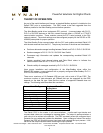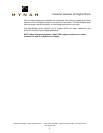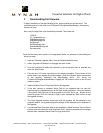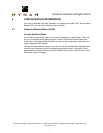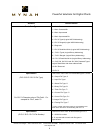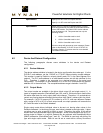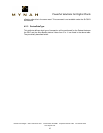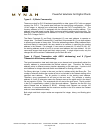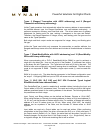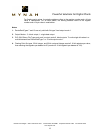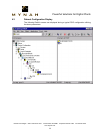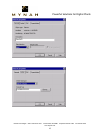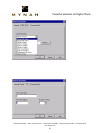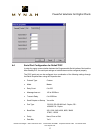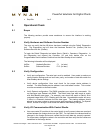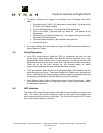
Powerful Solutions for Digital Plants
MYNAH Technologies 504 Trade Center Blvd. Chesterfield, MO 63005 Telephone 636 681-1555 Fax 636 681-1660
www.mynah.com
12
Types 5 (Ranged Transaction with ASCII addressing) and 9 (Ranged
Transaction with binary addressing):
Unlike Typed operations that automatically adjust the memory address to accommodate
the defined element type, the Ranged operations use word address exclusively. It
performs consecutive memory word read and write. The driver takes care of address
adjustment for floating point file type, making it transparent to the user and DeltaV.
Therefore, the Ranged operation on integer, binary, and floating point file types are the
same as the Typed operation.
Both single and block output modes are supported for integer, binary, and floating point
file type.
Unlike the Typed read which only accesses the accumulator or position attribute, the
Ranged read always starts at the first attribute and includes all three attributes in the data
file.
Types 7 (Read-Modify-Write with ASCII addressing) and 10 (Read-Modify-
Write with binary addressing):
When communicating with a PLC-5, Read-Modify-Write (RMW) is used to set/reset a
single bit in the binary file. User can set any bit in the Dataset. It is different from writing
to the binary file with Typed write. The Typed write will write all 16 bits in the word. The
RMW let user write a single bit in any word, leaving other bit unaffected. The block output
mode is not supported in RMW. Therefore, single output mode (1) must be used with
RMW.
RMW is for output only. The data direction parameter in the Dataset configuration must
be “output”. Configuring RMW as input to PSIC will cause error and undesirable results.
Type 11 (SLC 500, SLC 5/03 and SLC 5/04 Protected Typed Logical
Read/Write with three address fields):
This DeviceDataType is used to read/write all available tables (including the Input and
Output tables) of the SLC processors listed. The reads and writes are from/to the logical
address generated based on the starting address of the dataset. The following describes
the parameters and their usage:
Input, Output, and Binary tables can be defined as Boolean, Discrete or 16-bit UINT.
When using Boolean or Discrete, the starting address is always a 16-bit word address (0,
16, 32, etc), and the Number of Values refers to bits. For example, a Dataset with starting
address at 0 and 32 values gives you 32 bits. When using 16-bit UINT, the starting
address can be anywhere in the table, and the Number of Values refers to 16-bit
registers.
Input tables are read only. Output tables can be read and written. When performing
reads/writes to the Output table, the driver will access the SLC on a 16-bit word basis. If
the Output mode in DeltaV is 0 (i.e., Block), the entire block will be written if any bit in the
Dataset changes. On the other hand, if the Output mode is 1 (i.e., Single Value), then on
a single bit change, the 16-bit word containing that bit will be written.



